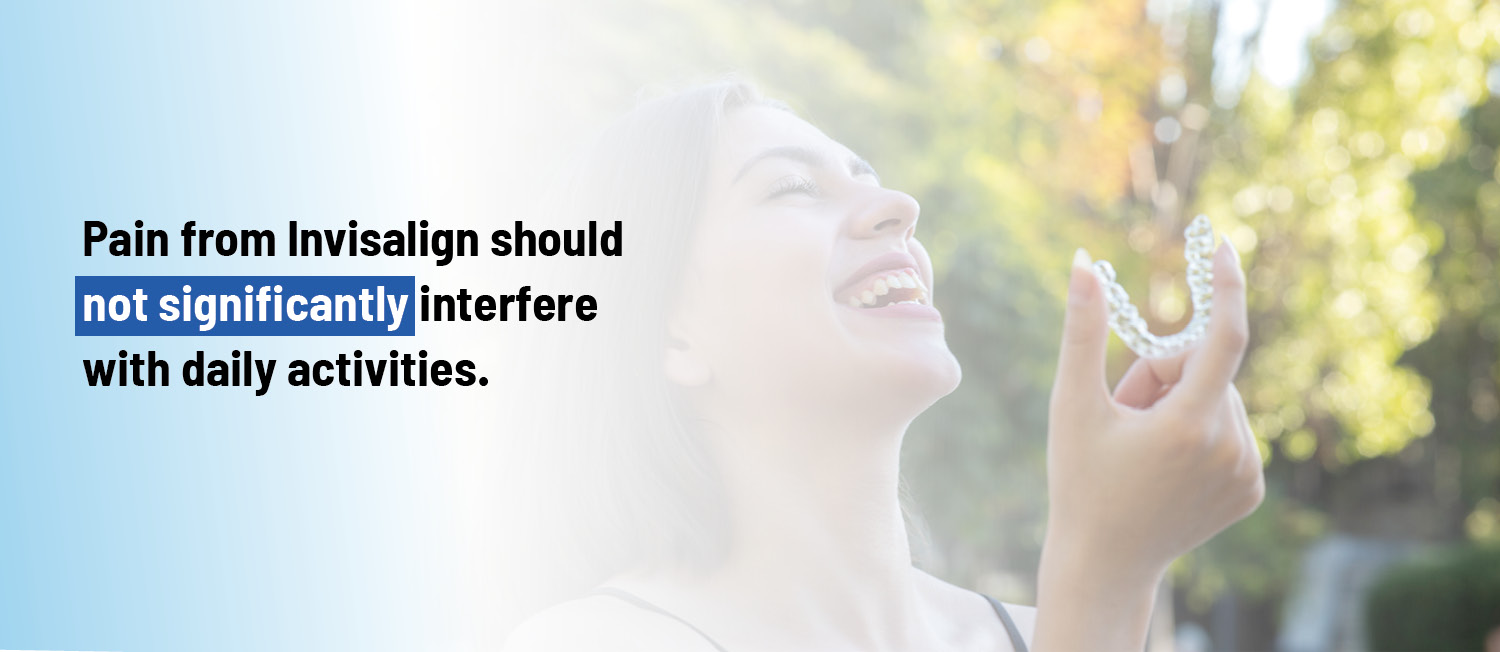Invisalign has proven to be an effective treatment with overall very positive reviews when it comes to perfecting a smile. In some cases, it can even help in the treatment of temporomandibular joint issues. However, as with many dental and orthodontic treatments, patients might find that they experience some pain and discomfort. For those experiencing pain from Invisalign for the first time, it can be comforting to know that it is common and to understand why it is happening.
Is it Normal to Experience Pain From Invisalign?
Many patients report mild pain with Invisalign. According to a 2005 study by The Journal of Orofacial Orthopedics, 54% of Invisalign users reported mild pain or discomfort, while 35% reported no pain at all. Additionally, 44% of the patients had difficulty chewing due to sensitivity. Taking this into account, patients are more likely to experience some pain than to experience none, making mild pain normal.
Still, the pain from Invisalign treatments is typically less than traditional fixed braces. For patients worried about dental pain, Invisalign may be the better choice between the two, but this depends on other factors as well.
Although mild pain is common with Invisalign, severe pain is rare. If Invisalign is causing significant pain or discomfort, the Invisalign provider should be contacted to fix the problem.

Typical Reasons for Invisalign Discomfort and Pain
There are a few reasons that Invisalign can hurt or cause discomfort. Some of these are a normal part of the process of switching out Invisalign trays every two weeks, while some are due to defects in the tray.
- Pressure and Movement of Teeth
Invisalign trays are designed to cause slight pressure on teeth to slowly move them over each two week interval between new trays. Naturally, this pressure can cause slight, dull pain and discomfort over the first 1-3 days after beginning treatment or switching to a new tray.
The teeth should adjust accordingly and the pain should subside within the first few days. However, for some users the discomfort and slight pain can recur every time a new tray is introduced and then subsides again within a couple of days.
- Rough Edges or Poorly Made Aligner Trays
In some cases, there might be defects in the Invisalign trays that can cause irritation due to hard bits of plastic rubbing against the gums. If a patient is experiencing sharp pains in the gums or severe pain in the teeth, this might be due to an ill-fitting tray.
This kind of pain is not normal and should be fixed by the Invisalign provider. Rough edges can be smoothed out or a new, better-fitting tray can be made. Luckily, this is not usually a problem with modern Invisalign trays.
- Deformed Aligner Trays
Invisalign aligner trays can sometimes become deformed when exposed to heat or if they are not handled carefully. Heat damage can occur by warping from hot water used to clean the tray or by being left in a hot car. This deformation can cause the tray to fit improperly or rub against the gums in a similar way to poorly made trays, causing the user to feel like their Invisalign hurts.
If a tray becomes deformed, it will most likely need to be remade. Wearing deformed trays can delay treatment, along with causing unnecessary pain.
- Pain When Removing Invisalign Trays
Invisalign trays are meant to be in a patient’s mouth for around 22 hours a day, but they need to be removed before eating and drinking, as well as for brushing and flossing. Some patients report irritation or pain when removing their trays. This kind of pain can be reduced by following the recommendations mentioned here.
How to Reduce Invisalign Discomfort and Pain
While minor pain and discomfort from Invisalign is inevitable for some people, there are ways to reduce this pain. Below are some tips for dealing with pain from Invisalign.
- Avoid hard or crunchy foods, like carrot sticks, nuts, or potato chips, during times when teeth are feeling sensitive.
- Take over-the-counter pain relievers.
- Start new aligner trays before bed to avoid the initial period of pain while adjusting to the new aligner.
- Try dental wax on sharp tray edges until the tray is fixed by an orthodontist or dentist.
- Sometimes chewing can relieve the pain associated with Invisalign. Products like Chewies, which are designed to help Invisalign fit better, can help with pain in some cases.
- Try cold compresses or drinks, but avoid chewing on ice.
When to Report Invisalign Pain
Pain from Invisalign should not significantly interfere with daily activities. If pain is severe or lasts longer than a few days after switching to a new tray, the dentist or orthodontist should be contacted to check for issues. They should also be contacted if it seems like a tray is deformed or ill-fitting or it is scratching the gums. Report any bleeding, swelling, or trouble swallowing right away.
To find an Invisalign provider or to find out if Invisalign is a good option, check out our dentist locator and make an appointment.


